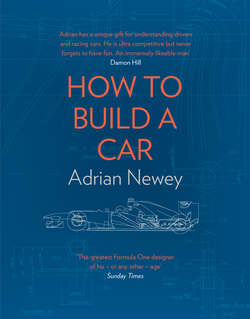Читать книгу How to Build a Car: The Autobiography of the World’s Greatest Formula 1 Designer - Adrian Newey, Adrian Newey - Страница 9
ON THE GRID
CHAPTER 7
ОглавлениеWhile at university I’d written to Gordon Murray, chief designer at Brabham, telling him how highly I thought of him, as well as outlining an idea I’d had for a suspension system that kept the camber of the wheels upright in cornering.
I loved Brabham. I’d got to know a few of their guys from using the Southampton wind tunnel, and I thought the idea was a good one. Moreover, since Brabham was the only team apart from Ferrari to use a transverse gearbox, which was more suitable for my suspension system idea than a conventional longitudinal gearbox, they were the perfect recipients for it.
With hindsight, the concept wasn’t so great. It would have been difficult to get it stiff enough without compromising the structure of the chassis. Gordon, who all these years later still remembers me writing to him, replied in characteristically polite terms, letting me down gently but offering me encouragement for the future. Along with March, where Ian Reed had ended up, Brabham had gone to the top of my hit list when it came to looking for a job post-graduation.
But when I enquired, neither of them had an opening. Nor did any of the other dozen or so teams in both Formula One and Two that I subsequently wrote to – a large and costly carpet-bombing operation that involved sending photocopied extracts from my university project in order to convince them of my brilliance.
Roughly half simply ignored me. Most of the rest replied with the ‘Catch 22’ answer that they wanted someone with experience. Tyrell Racing offered me an interview, and subsequently a job subject to sponsorship. But the sponsorship didn’t come through so the job didn’t either, although they were impressed with the extract.
As were Tiga, a Formula Two team out of Caversham near Reading. Theirs was a nice, tidy workshop run by a couple of Aussies, Tim Schenken and Howden Ganley. During my interview with Schenken, Ganley returned from a trip to Reading library laden down with books, apparently hoping to understand how to design and build his own wind tunnel. I admired his can-do spirit, but building a wind tunnel after a visit to Reading library felt somewhat optimistic.
Still, they were a likeable pair, and they too offered me a job subject to sponsorship. Which never arrived, meaning neither did the job.
In desperation I went for an interview at British Leyland, an all-day thing where I joined a bunch of other applicants. The worker in charge of my group told us he’d spent the previous year performing stress-analysis tests on the tailgate of a Morris Ital estate car, and I thought to myself, I don’t think I can do that – spend a whole year performing stress-analysis tests on a tailgate.
We went for lunch and, gazing out of the canteen windows, we could see a car shrouded in what looked like black bin liners doing circuits of a test track. There was great excitement among the other candidates. Could it be …? Was this the exciting new British Leyland car? The Metro. That confirmed my worry: I definitely cannot do this job and remain sane!
Way more encouraging was a job offer from Lotus, except that, typical of my luck at the time, it wasn’t Lotus the racing team but Lotus road cars. And while I had personal history with Lotus road cars, and there was always a chance I might be able to attract attention from the team, their big hit of the time was the Lotus Esprit, which I thought was an ugly, awful thing enjoying unwarranted popularity thanks to its appearance in The Spy Who Loved Me.
Arriving for an interview I was struck by the fact that the factory was an utter pigsty. As well as the Esprit, bits of which I saw were made of thick, poorly contoured fibreglass, they were deep into research and design for the DeLorean, which had all the hallmarks of the design monstrosity it would later prove to be.
Still, it was a job offer, the best I had, and I was about to accept – on the verge of doing so, in fact – when the phone rang.
At the other end was Harvey Postlethwaite, technical director at Fittipaldi Automotive and already on the road to becoming a design legend, with a later stint at Ferrari sealing the deal in that regard.
Harvey liked the project sample I’d sent. Would I come for an interview?
A day or so later I rode into the Fittipaldi HQ at Reading, which turned out to be a small factory unit, a couple of Portacabin offices and a herringbone car park. Sitting in reception, still in my biking leathers, I was greeted by Harvey, hair a mess, big grin on his face.
‘You’re a biker,’ he said, delighted by the sight of my leathers. ‘What have you got?’
‘Ducati 900SS,’ I told him.
‘Fantastic,’ he said, ‘mine’s a Moto Guzzi Le Mans.’
This was a time when one of the hot points of discussion in the bike magazines was about which was the superior Italian bike, Moto Guzzi or Ducati. Harvey was eager for first-hand experience and asked if he could take my Ducati out for a spin.
‘Sure,’ I said, and stood in the car park for what felt like an age as he took my bike for a run God knows where, returning and taking off his helmet to reveal even messier hair and an even bigger grin.
‘Right,’ he said, ‘when can you start?’
As interviews go, it beat sitting in the British Leyland canteen.
